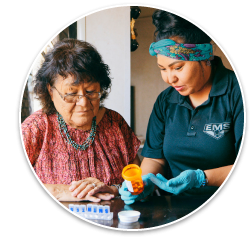Community paramedicine, often implemented alongside mobile integrated health programs (MIH-CP), is an innovative care model that expands the role of paramedics and emergency medical technicians, enabling them to provide a broader range of nonemergency home- and community-based services.
How do community paramedicine programs work?
Typically delivered through partnerships between health care organizations and emergency medical service (EMS) delivery systems, MIH-CP models connect patients to crucial evidence-based services, including hospital follow-up care, care management, medication reconciliation, health education, and connections to community resources. Connecting with patients either following 9-1-1 calls, emergency department (ED) visits or hospitalizations, or provider referrals, MIH-CP models empower paramedic and EMS staff to deliver a broader spectrum of home-based care, often allowing for more extended interaction with patients compared to typical emergency situations. Additionally, some programs integrate interdisciplinary team members such as social workers and pharmacists, either as part of a mobile care team or through telehealth.
EVIDENCE ROUNDUP
This blog post is part of a Playbook series connecting evidence and implementation resources with emerging state and federal policies to help enhance services for people with complex needs.
What gaps can community paramedicine fill?
MIH-CP programs can play an important role in increasing access to primary, preventive, and follow-up care services; improving health outcomes; and reducing preventable acute care utilization. By bringing health care services directly to individuals, MIH-CP programs offer opportunities to reduce disparities in access to care often experienced in rural communities, and to improve care for individuals with complex health and social needs in a range of geographic regions.
How are communities designing MIH-CP programs?
The following Playbook resources offer insight into how MIH-CP models have been designed across the country and tools for implementation:
- The Paramedic Will See You Now: Expanding Access to Community-Based Care for People with Complex Needs – This Playbook webinar highlighted two community paramedicine programs — instED in New England and Community CaraMedic at Mission Health Partners in North Carolina — that serve people with complex needs. Program leaders and community paramedics from these programs shared insights on program design and workflow, payment and funding, implementation tips, and outcomes.
- Implementing and Sustaining Rural Community Paramedicine – This report, informed by a convening of MIH-CP providers and related stakeholders, offers strategies to support the implementation and sustainability of MIH-CP programs in rural communities.
- Rural Community Paramedicine Toolkit – This toolkit provides health care stakeholders in rural areas with practical information to support in designing, implementing, and evaluation community paramedicine programs. While tailored specifically for rural communities, the toolkit also offers valuable insights and implementation considerations that can benefit stakeholders in diverse geographic regions.
What is the evidence behind MIH-CP programs?
There is a growing body of promising evidence demonstrating the effectiveness of MIH-CP programs at improving patient outcomes. This evidence aligns with a broader understanding of the preventable nature of a significant portion of ED visits and the advantages of delivering home-based services to individuals with complex health and social needs. Health care providers, insurers, local and state governments, and other stakeholders can use the following Playbook resources to understand the feasibility of implementing MIH-CP programs in various settings and the potential impact on key outcomes, such as ED visits and hospital readmissions.
- Community Paramedicine in Central Oregon: A Promising Model to Reduce Non-Urgent Emergency Department Utilization Among Medically Complex Medicaid Beneficiaries – This randomized controlled trial measuring the impact of a community paramedicine model implemented in two rural Oregon counties showed reductions in both urgent ED visits (14%) and in ED visits identified as avoidable (40%).
- Queen Anne's County Mobile Integrated Community Health Program – A comparison of pre- and post-intervention patient records among those enrolled in an MIH-CP model in a rural Maryland county revealed reductions in emergency services, ED visits and hospital readmissions, and an average savings of $14,566 per patient.
- Evaluating the Impact of a Mobile Integrated Health‒Community Paramedicine Program on Health-Related Social Needs and Hospital Readmissions – A pilot MIH-CP program implemented by the Baltimore City Fire Department and the University of Maryland Medical Center, and using an interdisciplinary care team, was successful in addressing patients’ medication-related and care coordination needs and reducing hospital readmission rates.
- Evaluation of AB 1544: Community Paramedicine and Triage to Alternate Destination – The results of a multi-year evaluation of community paramedicine and triage to alternative destination programs across California show improvements in the coordination of medical, behavioral health and social services, as well as reductions in ambulance transports, ED visits and hospital readmissions.
What are policy and sustainability considerations?
Despite promising evidence, sustainability challenges often hinder the long-term impact of MIH-CP models. A recent survey found that 38% of MIH-CP programs across the nation that ceased operations in the last three years attributed their closure to funding, staffing, or resource shortages. Enabling reimbursement for EMS treatment without transportation provision is a key policy lever available to states and the federal government to address these sustainability challenges. Temporary pandemic-related flexibilities granted by the Centers for Medicare & Medicaid Services, which allowed for Medicare reimbursement of EMS staff for providing treatment in place, have been cited as a key driver of greater proliferation of MIH-CP programs. As of 2022, some states, including Arizona, Georgia, Minnesota, Nevada, and Wyoming, have implemented Medicaid reimbursement for MIH-CP services, while others have eliminated regulatory barriers preventing EMS staff from providing treatment in place, leading to broader coverage by commercial insurers.
Share Your Community Paramedicine Program Resources
Do you have a resource or emerging best practice related to MIH-CP programs? Share your experience with the Playbook. We are interested in growing our library of evidence and implementation best practices to help those in the field strengthen and build successful MIH-CP programs in communities across the nation.

